by Gary Alexander
June 18, 2024
In 1977, Congress created “dual mandates” for the Federal Reserve by amending the Federal Reserve Act to direct the Fed’s Open Market Committee to maintain the “growth of the monetary and credit aggregates commensurate with the economy’s long run potential to increase production, so as to promote effectively the goals of maximum employment, stable prices and moderate long-term interest rates.”
Putting aside for the moment the fact that the preceding sentence ends with three, not two, mandates, we must recall the context of 1977, which included high inflation and rising jobless rates, giving birth to the term “stagflation.” This flew in the face of the Phillips Curve, which purported to say that we either faced high inflation or high unemployment, but not both simultaneously. This new reality, in turn, gave rise to “the misery index,” which combined the jobless and inflation rates, which both reached double digits in the late 1970s, after this dual mandate was created. The misery index peaked at 22% in June of 1980.
The Fed’s target rates evolved to 2% inflation and 4% unemployment, netting a non-miserable 6% total.
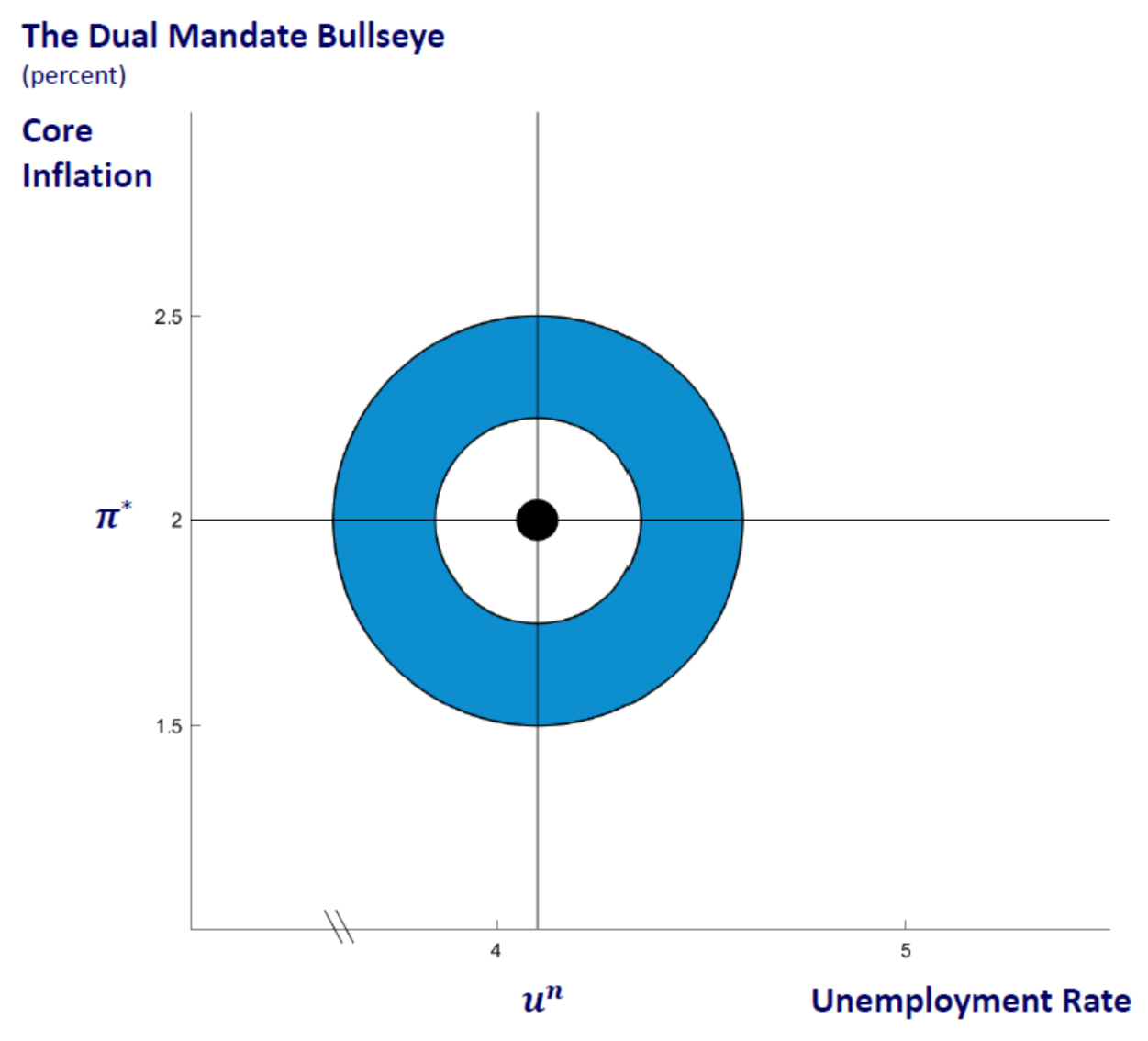
Graphs are for illustrative and discussion purposes only. Please read important disclosures at the end of this commentary.
How is the current Fed doing? Let’s look at the latest iterations of their two major mandates:
Mandate #1: Jobs Rose 272,000 in May – That’s Great News, Right? (Sorry, No)
Here’s a case study in deceptive numbers. Gold bullion prices fell $100 per ounce early Friday morning, June 7, on the release of a “strong jobs report,” with a healthy 272,000 “non-farm payroll jobs” created in May, well above the projected numbers. According to weak-kneed gold ETF traders, a strong jobs report implies that the Fed will take longer to start cutting interest rates and “since gold doesn’t offer interest income,” higher rates for longer puts gold at a disadvantage. This reasoning flies against the fact that gold has often (1976-80, 2004-07 and during the latest rate increase, 2022-23) risen when interest rates have risen, but the ignorance of such traders runs even deeper. They often sell first, think second (if at all). If they would spend a few minutes to search out the details about the May jobs report, hardly any line item beyond the headline was positive:
- There are two job totals released each month. (1) The headline payroll total showed 272,000 jobs created, which everyone reported, but (2) the equally important household survey showed a 408,000 decline in workers last month. (The household survey tends to reflect workers in small businesses.)
- Part-time jobs grew by 286,000, while full-time workers fell by 625,000.
- Foreign-born workers grew by 414,000, while jobs for native-born Americans declined by 663,000.
- The civilian labor force shrank by 250,000 workers, netting a rise in the unemployment rate to 4.0%
The basic problem is that we think all jobs are equal, but that’s not the case. In the past year, more part-time jobs (1,511,000) were created than full-time jobs (1,163,000), and more government jobs were created in the last three years than in any three-year period in history. In private sector jobs, healthcare led the way, and they are often subsidized by Obamacare or Medicare, so why is this a “positive” jobs report?
In the post-pandemic world, real wages are shrinking, and the worker-to-population ratio has shrunk, too, netting far more part-time gig jobs counted as “payroll job growth” plus off-the-book work. In spite of a small post-pandemic pick-up, the male civilian labor force participation rate is still in a long-term decline.
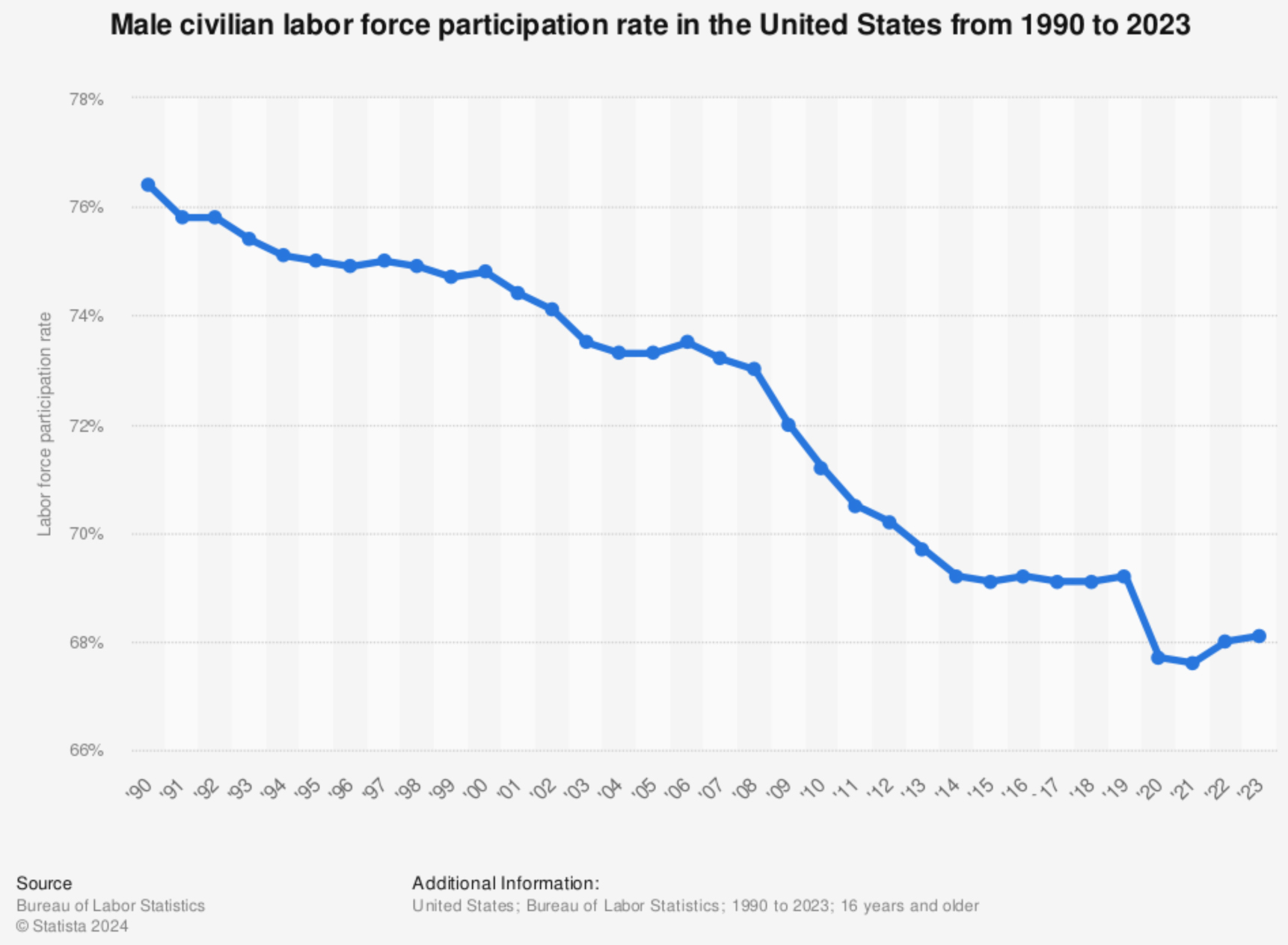
Graphs are for illustrative and discussion purposes only. Please read important disclosures at the end of this commentary.
Mandate #2: Inflation Is Finally Down – Right? (Sorry, Not for Most People)
Last Wednesday, the Labor Department announced that the Consumer Price Index (CPI) was unchanged in May, and the Producer Price Index (PPI) did even better, declining 0.2%. In the past 12 months, the PPI has risen 2.2%, with the core PPI rising 2.3% in the past 12 months, so the PPI is close to the Fed’s target.
Both mandates are near target range, yet Chairman Powell is not ready to take a victory lap, saying, “We’ll need to see more good data to bolster our confidence that inflation is moving sustainably toward 2%.” But at least inflation is moving in the right direction, depending on your perspective and wealth profile, right?
Rich folks are doing fine. Rising prices don’t hurt them, but for younger folks looking to buy a house, or living paycheck to paycheck, inflation is horrendous. Mortgage rates haven’t retreated, even when 10-year bonds drop in yield. Credit card debt and car loan rates have soared. Auto insurance is up 26% in the last year, and +51% in three years. Home ownership insurance is up 30%, as are property valuations for taxes.
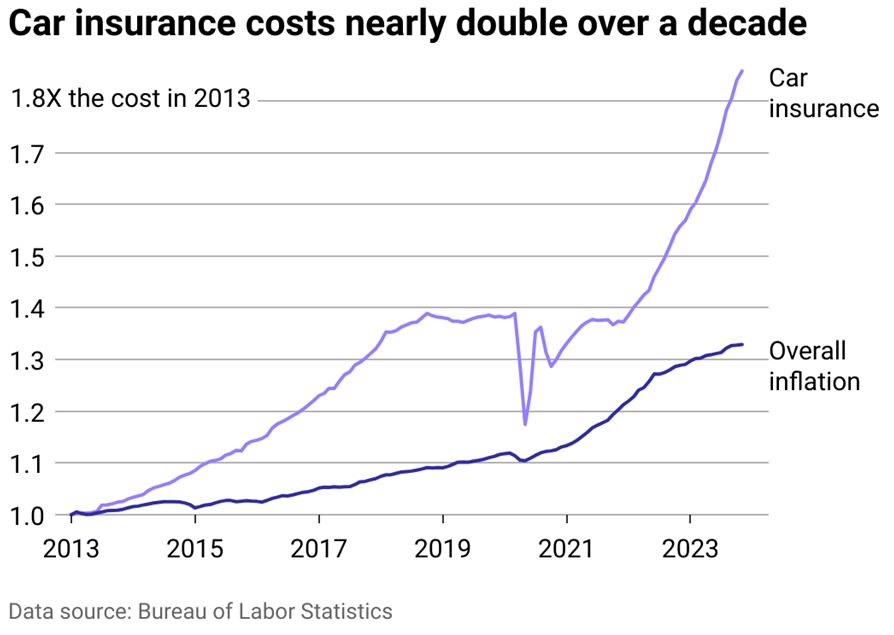
Graphs are for illustrative and discussion purposes only. Please read important disclosures at the end of this commentary.
The rising costs of servicing debts are huge, but they are not reflected in any cost of living or inflation index. Neither are higher taxes when inflation pushes you into a higher tax bracket. Part of this is included in owners’ equivalent rent, but that is just a down payment on the debt overhang of rising mortgage rates.
The Fed’s Hidden Mandate #3 – Financing Fiscal Follies
It’s time to touch the untouchable. The Fed’s “employment mandate” should be abandoned. They can’t make workers work. They can’t set wages or tax rates. And the inflation mandate is only controllable if they aren’t asked to finance the huge and growing deficits “mandated” by the political Parties in power. As for interest rates, the market (the bond vigilantes) set those. The Fed follows them, so forget that mandate.
Instead of the old dual mandate, perhaps the Fed should have only one mandate – their original mandate: Preserve the value of the dollar, and then supervise the banks on the side, but it cannot address the pesky third rail, Fiscal policy. The Fed is obligated to provide the liquidity Congress demands. Former Fed Chairmen Paul Volcker and Alan Greenspan directly or indirectly urged Congress to control their spending, but recent Fed chairs, notably Jerome Powell, have done the opposite, urging Congress to stimulate the economy during COVID, even after the economy revived quickly after the initial lockdown. As a result, we now see $2 trillion federal deficits per year, in times of peace and prosperity, unprecedented in history.
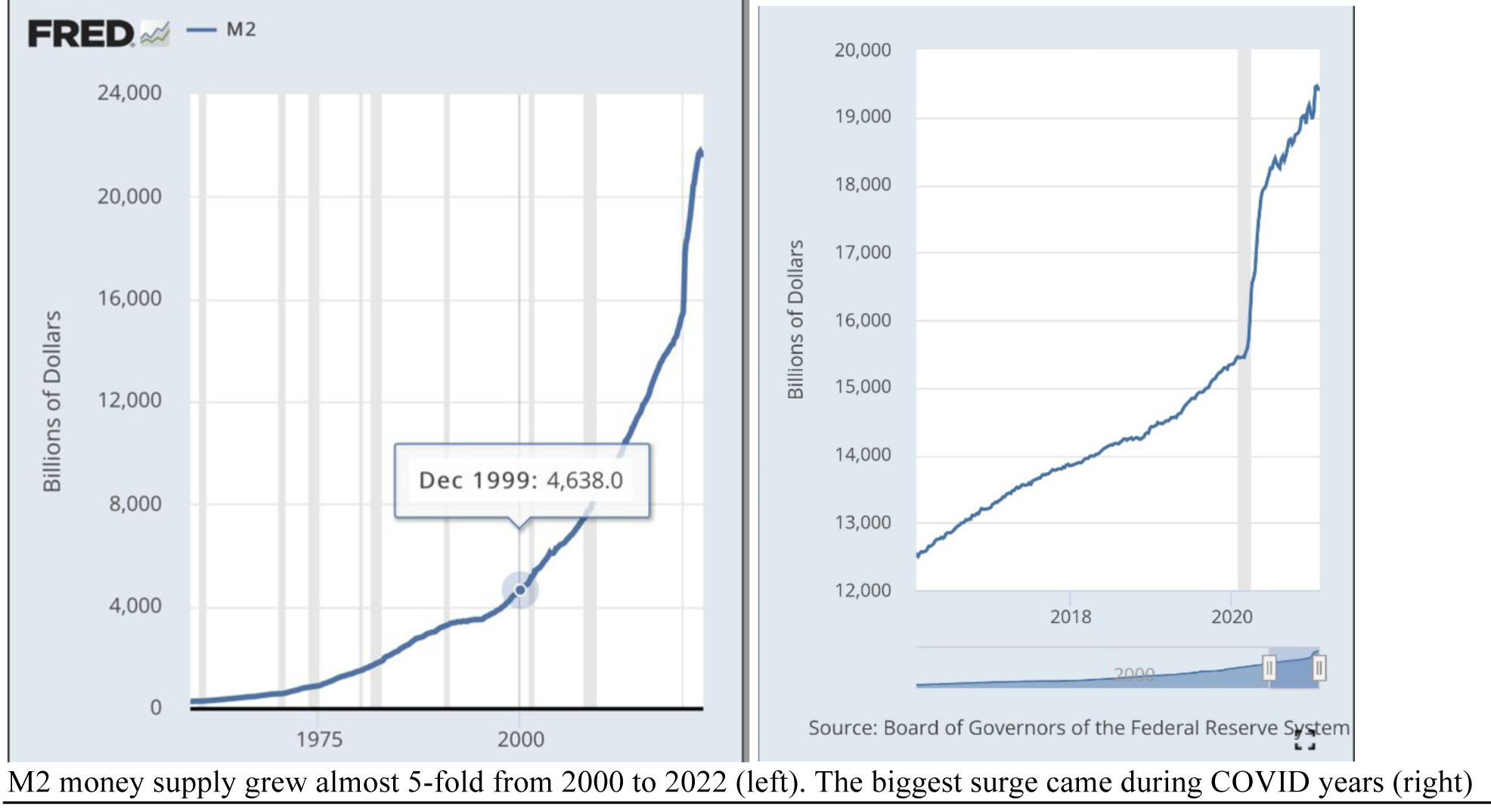
Graphs are for illustrative and discussion purposes only. Please read important disclosures at the end of this commentary.
In the 90 years since the birth of Franklin Roosevelt’s New Deal in 1933, total federal spending rose from just over $5 billion per year to $6.5 trillion, according to calculations by Joseph Bessette, Professor of Government and Ethics at Claremont Colleges. Adjusted for inflation, spending is 77 times higher than in 1933 and domestic spending is 125 times higher, while population grew just 2.5 times, so real per capita spending is up 30-fold overall and 50-fold in social spending. Bessette says, “No political development in the U.S. in the 20th century rivals in importance the growth of the massive social welfare state.”
Yet here we are in 2024 saying that we “haven’t done enough” for the poor, and there is a great divide of wealth. Alan Blinder, former Vice-Chairman of the Fed under Greenspan in the mid-1990s, wrote an Op-Ed in The Wall Street Journal (“Shore Up the Social Safety Net with Pre-distribution,” June 7), saying that the U.S. is rich enough to expand transfer payments, writing that “22.7% of U.S. gross domestic product is social spending, compared with 31.6% in France,” yet he fails to track the trajectory of these two nations.
In 1980, France’s GDP per capita ($12,739) was actually higher than America’s ($12,575). Today, France’s GDP per capita ($44,408) is barely half of America’s ($81,632). That’s because their generous welfare program combined with lax labor laws (like six weeks’ paid vacation), a high jobless rate and few children bankrupted their coffers. You need enough ambitious, hard workers to create big benefits for the masses.
As a result of this GDP gap, America’s social spending per person is now $19,000 vs. $15,000 per person in France and Germany. The magic formula is: You must create wealth before you can redistribute it.
Please remember these financial realities when you visit a voting booth near you this coming November.
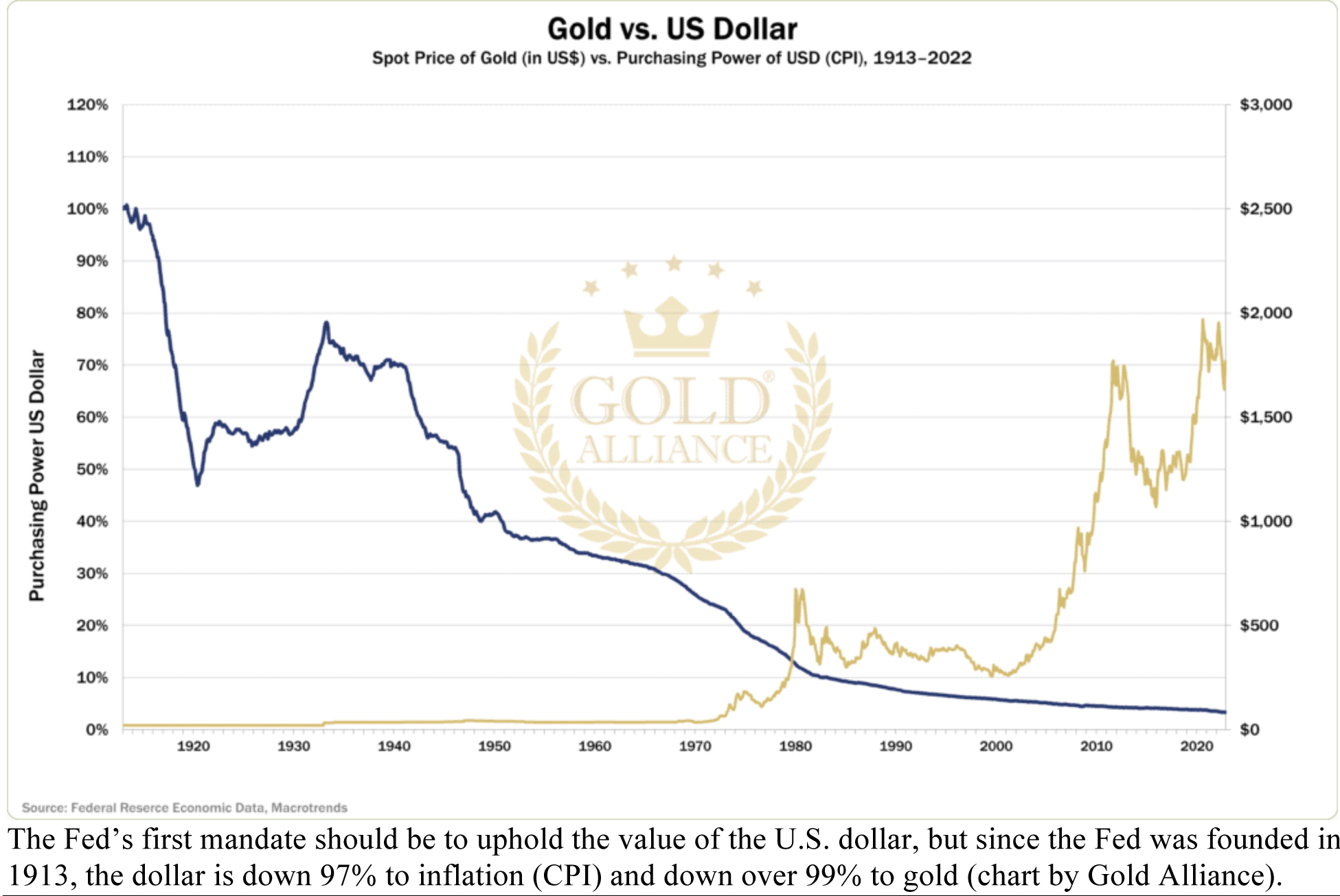
Graphs are for illustrative and discussion purposes only. Please read important disclosures at the end of this commentary.
All content above represents the opinion of Gary Alexander of Navellier & Associates, Inc.
Also In This Issue
A Look Ahead by Louis Navellier
Powell Needs to Face Reality – and Take Control
Income Mail by Bryan Perry
The Market Just Got Real Simple, Real Fast, For Most Investors
Growth Mail by Gary Alexander
The Data-Dependent Fed Relies on Deceptive Data to Meet its Misleading Mandates
Global Mail by Ivan Martchev
Beware the Franco-German Spread
Sector Spotlight by Jason Bodner
While in Europe, I Take a Closer Look at Travel & Leisure Stocks
View Full Archive
Read Past Issues Here
About The Author

Gary Alexander
SENIOR EDITOR
Gary Alexander has been Senior Writer at Navellier since 2009. He edits Navellier’s weekly Marketmail and writes a weekly Growth Mail column, in which he uses market history to support the case for growth stocks. For the previous 20 years before joining Navellier, he was Senior Executive Editor at InvestorPlace Media (formerly Phillips Publishing), where he worked with several leading investment analysts, including Louis Navellier (since 1997), helping launch Louis Navellier’s Blue Chip Growth and Global Growth newsletters.
Prior to that, Gary edited Wealth Magazine and Gold Newsletter and wrote various investment research reports for Jefferson Financial in New Orleans in the 1980s. He began his financial newsletter career with KCI Communications in 1980, where he served as consulting editor for Personal Finance newsletter while serving as general manager of KCI’s Alexandria House book division. Before that, he covered the economics beat for news magazines. All content of “Growth Mail” represents the opinion of Gary Alexander
Important Disclosures:
Although information in these reports has been obtained from and is based upon sources that Navellier believes to be reliable, Navellier does not guarantee its accuracy and it may be incomplete or condensed. All opinions and estimates constitute Navellier’s judgment as of the date the report was created and are subject to change without notice. These reports are for informational purposes only and are not a solicitation for the purchase or sale of a security. Any decision to purchase securities mentioned in these reports must take into account existing public information on such securities or any registered prospectus.To the extent permitted by law, neither Navellier & Associates, Inc., nor any of its affiliates, agents, or service providers assumes any liability or responsibility nor owes any duty of care for any consequences of any person acting or refraining to act in reliance on the information contained in this communication or for any decision based on it.
Past performance is no indication of future results. Investment in securities involves significant risk and has the potential for partial or complete loss of funds invested. It should not be assumed that any securities recommendations made by Navellier. in the future will be profitable or equal the performance of securities made in this report. Dividend payments are not guaranteed. The amount of a dividend payment, if any, can vary over time and issuers may reduce dividends paid on securities in the event of a recession or adverse event affecting a specific industry or issuer.
None of the stock information, data, and company information presented herein constitutes a recommendation by Navellier or a solicitation to buy or sell any securities. Any specific securities identified and described do not represent all of the securities purchased, sold, or recommended for advisory clients. The holdings identified do not represent all of the securities purchased, sold, or recommended for advisory clients and the reader should not assume that investments in the securities identified and discussed were or will be profitable.
Information presented is general information that does not take into account your individual circumstances, financial situation, or needs, nor does it present a personalized recommendation to you. Individual stocks presented may not be suitable for every investor. Investment in securities involves significant risk and has the potential for partial or complete loss of funds invested. Investment in fixed income securities has the potential for the investment return and principal value of an investment to fluctuate so that an investor’s holdings, when redeemed, may be worth less than their original cost.
One cannot invest directly in an index. Index is unmanaged and index performance does not reflect deduction of fees, expenses, or taxes. Presentation of Index data does not reflect a belief by Navellier that any stock index constitutes an investment alternative to any Navellier equity strategy or is necessarily comparable to such strategies. Among the most important differences between the Indices and Navellier strategies are that the Navellier equity strategies may (1) incur material management fees, (2) concentrate its investments in relatively few stocks, industries, or sectors, (3) have significantly greater trading activity and related costs, and (4) be significantly more or less volatile than the Indices.
ETF Risk: We may invest in exchange traded funds (“ETFs”) and some of our investment strategies are generally fully invested in ETFs. Like traditional mutual funds, ETFs charge asset-based fees, but they generally do not charge initial sales charges or redemption fees and investors typically pay only customary brokerage fees to buy and sell ETF shares. The fees and costs charged by ETFs held in client accounts will not be deducted from the compensation the client pays Navellier. ETF prices can fluctuate up or down, and a client account could lose money investing in an ETF if the prices of the securities owned by the ETF go down. ETFs are subject to additional risks:
- ETF shares may trade above or below their net asset value;
- An active trading market for an ETF’s shares may not develop or be maintained;
- The value of an ETF may be more volatile than the underlying portfolio of securities the ETF is designed to track;
- The cost of owning shares of the ETF may exceed those a client would incur by directly investing in the underlying securities; and
- Trading of an ETF’s shares may be halted if the listing exchange’s officials deem it appropriate, the shares are delisted from the exchange, or the activation of market-wide “circuit breakers” (which are tied to large decreases in stock prices) halts stock trading generally.
Grader Disclosures: Investment in equity strategies involves substantial risk and has the potential for partial or complete loss of funds invested. The sample portfolio and any accompanying charts are for informational purposes only and are not to be construed as a solicitation to buy or sell any financial instrument and should not be relied upon as the sole factor in an investment making decision. As a matter of normal and important disclosures to you, as a potential investor, please consider the following: The performance presented is not based on any actual securities trading, portfolio, or accounts, and the reported performance of the A, B, C, D, and F portfolios (collectively the “model portfolios”) should be considered mere “paper” or pro forma performance results based on Navellier’s research.
Investors evaluating any of Navellier & Associates, Inc.’s, (or its affiliates’) Investment Products must not use any information presented here, including the performance figures of the model portfolios, in their evaluation of any Navellier Investment Products. Navellier Investment Products include the firm’s mutual funds and managed accounts. The model portfolios, charts, and other information presented do not represent actual funded trades and are not actual funded portfolios. There are material differences between Navellier Investment Products’ portfolios and the model portfolios, research, and performance figures presented here. The model portfolios and the research results (1) may contain stocks or ETFs that are illiquid and difficult to trade; (2) may contain stock or ETF holdings materially different from actual funded Navellier Investment Product portfolios; (3) include the reinvestment of all dividends and other earnings, estimated trading costs, commissions, or management fees; and, (4) may not reflect prices obtained in an actual funded Navellier Investment Product portfolio. For these and other reasons, the reported performances of model portfolios do not reflect the performance results of Navellier’s actually funded and traded Investment Products. In most cases, Navellier’s Investment Products have materially lower performance results than the performances of the model portfolios presented.
This report contains statements that are, or may be considered to be, forward-looking statements. All statements that are not historical facts, including statements about our beliefs or expectations, are “forward-looking statements” within the meaning of The U.S. Private Securities Litigation Reform Act of 1995. These statements may be identified by such forward-looking terminology as “expect,” “estimate,” “plan,” “intend,” “believe,” “anticipate,” “may,” “will,” “should,” “could,” “continue,” “project,” or similar statements or variations of such terms. Our forward-looking statements are based on a series of expectations, assumptions, and projections, are not guarantees of future results or performance, and involve substantial risks and uncertainty as described in Form ADV Part 2A of our filing with the Securities and Exchange Commission (SEC), which is available at www.adviserinfo.sec.gov or by requesting a copy by emailing info@navellier.com. All of our forward-looking statements are as of the date of this report only. We can give no assurance that such expectations or forward-looking statements will prove to be correct. Actual results may differ materially. You are urged to carefully consider all such factors.
FEDERAL TAX ADVICE DISCLAIMER: As required by U.S. Treasury Regulations, you are informed that, to the extent this presentation includes any federal tax advice, the presentation is not written by Navellier to be used, and cannot be used, for the purpose of avoiding federal tax penalties. Navellier does not advise on any income tax requirements or issues. Use of any information presented by Navellier is for general information only and does not represent tax advice either express or implied. You are encouraged to seek professional tax advice for income tax questions and assistance.
IMPORTANT NEWSLETTER DISCLOSURE:The hypothetical performance results for investment newsletters that are authored or edited by Louis Navellier, including Louis Navellier’s Growth Investor, Louis Navellier’s Breakthrough Stocks, Louis Navellier’s Accelerated Profits, and Louis Navellier’s Platinum Club, are not based on any actual securities trading, portfolio, or accounts, and the newsletters’ reported hypothetical performances should be considered mere “paper” or proforma hypothetical performance results and are not actual performance of real world trades. Navellier & Associates, Inc. does not have any relation to or affiliation with the owner of these newsletters. There are material differences between Navellier Investment Products’ portfolios and the InvestorPlace Media, LLC newsletter portfolios authored by Louis Navellier. The InvestorPlace Media, LLC newsletters contain hypothetical performance that do not include transaction costs, advisory fees, or other fees a client might incur if actual investments and trades were being made by an investor. As a result, newsletter performance should not be used to evaluate Navellier Investment services which are separate and different from the newsletters. The owner of the newsletters is InvestorPlace Media, LLC and any questions concerning the newsletters, including any newsletter advertising or hypothetical Newsletter performance claims, (which are calculated solely by Investor Place Media and not Navellier) should be referred to InvestorPlace Media, LLC at (800) 718-8289.
Please note that Navellier & Associates and the Navellier Private Client Group are managed completely independent of the newsletters owned and published by InvestorPlace Media, LLC and written and edited by Louis Navellier, and investment performance of the newsletters should in no way be considered indicative of potential future investment performance for any Navellier & Associates separately managed account portfolio. Potential investors should consult with their financial advisor before investing in any Navellier Investment Product.
Navellier claims compliance with Global Investment Performance Standards (GIPS). To receive a complete list and descriptions of Navellier’s composites and/or a presentation that adheres to the GIPS standards, please contact Navellier or click here. It should not be assumed that any securities recommendations made by Navellier & Associates, Inc. in the future will be profitable or equal the performance of securities made in this report.
FactSet Disclosure: Navellier does not independently calculate the statistical information included in the attached report. The calculation and the information are provided by FactSet, a company not related to Navellier. Although information contained in the report has been obtained from FactSet and is based on sources Navellier believes to be reliable, Navellier does not guarantee its accuracy, and it may be incomplete or condensed. The report and the related FactSet sourced information are provided on an “as is” basis. The user assumes the entire risk of any use made of this information. Investors should consider the report as only a single factor in making their investment decision. The report is for informational purposes only and is not intended as an offer or solicitation for the purchase or sale of a security. FactSet sourced information is the exclusive property of FactSet. Without prior written permission of FactSet, this information may not be reproduced, disseminated or used to create any financial products. All indices are unmanaged and performance of the indices include reinvestment of dividends and interest income, unless otherwise noted, are not illustrative of any particular investment and an investment cannot be made in any index. Past performance is no guarantee of future results.
